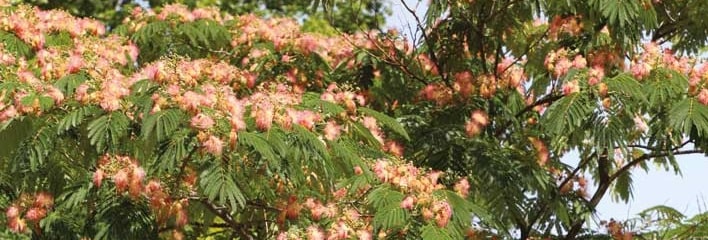The Albizia tree, also known as Albizia julibrissin, is commonly referred to as the “Silk Tree” or “Mimosa Tree” in English. This tree is appreciated for its distinctive feathery foliage, fragrant pink or white flowers, and fern-like leaves, which give it a unique and ornamental appearance. The name “Silk Tree” may be inspired by the silky texture of its flower clusters, and “Mimosa Tree” is used due to its resemblance to plants in the Mimosa genus.
Where is Albizzia julibrissin tree native?
Albizia julibrissin, commonly known as the Silk Tree or Mimosa Tree, is native to eastern and southwestern Asia. Its natural range includes countries in these regions. Specifically, the native range of Albizia julibrissin includes:

- Iran: Portions of Iran, particularly in the northern and western parts of the country, are within the native range of this tree.
- China: Various regions in China are part of the native range of Albizia julibrissin. It is native to areas in eastern and southeastern China.
- Korea: Some parts of the Korean Peninsula, including both North and South Korea, are within the native range of the Mimosa Tree.
- Japan: Albizia julibrissin is also native to certain regions of Japan.
In these countries, Albizia julibrissin grows in a variety of habitats, including open woodlands, along riverbanks, and in disturbed areas. Its popularity as an ornamental tree has led to its cultivation and presence in many other parts of the world, particularly in regions with temperate climates.
How to care for the Albizzia julibrissin tree
Caring for an Albizia julibrissin, commonly known as the Silk Tree or Mimosa Tree, involves several key considerations to help it thrive and maintain its health and beauty. Here are some care guidelines for this tree:
1. Location:
- Choose a well-draining location with full to partial sun. Silk Trees thrive in full sunlight but can tolerate some shade.
2. Soil:
- Provide well-draining soil. Albizia julibrissin can adapt to different soil types but prefers slightly acidic to neutral soil.
3. Watering:
- Maintain consistent soil moisture, especially during the tree’s establishment period. Water deeply when the soil is dry to a few inches below the surface. Avoid overwatering or allowing the tree to sit in waterlogged soil.
4. Mulching:
- Apply a layer of organic mulch around the base of the tree to help retain soil moisture, regulate soil temperature, and reduce weed competition. Keep the mulch away from the trunk.
5. Pruning:
- Prune as needed to remove dead or diseased branches, shape the tree, and maintain a balanced canopy. Pruning can be done in late winter or early spring.
6. Fertilization:
- While established Silk Trees are often low-maintenance, you can apply a balanced, slow-release fertilizer in early spring if the soil is nutrient-deficient. Avoid excessive fertilization, as it can lead to excessive vegetative growth and fewer flowers.
7. Pest and Disease Control:
- Monitor for common pests and diseases that may affect Albizia julibrissin, such as webworms, scale insects, or cankers. Take appropriate measures, such as pruning affected branches, using insecticidal soap, or applying fungicides when necessary.
8. Drought Tolerance:
- While Albizia julibrissin can tolerate some drought, especially when established, providing consistent moisture during dry periods can help prevent stress and leaf drop.
9. Wind Protection:
- Young Silk Trees may benefit from wind protection or staking to help establish their root systems and prevent wind damage.
10. Disease Resistance:
- Resistant cultivars of Albizia julibrissin are available that have improved resistance to certain pests and diseases. Consider these cultivars if you are in an area with known pest or disease issues.
11. Prudent Planting:
- When planting, choose an appropriate location and provide adequate spacing to accommodate the tree’s mature size. Plant away from structures, as the branches are brittle and can be prone to breaking in strong winds.
Remember that Albizia julibrissin can self-sow and may produce numerous seedlings if conditions are favorable. Regular pruning and maintenance can help manage the tree’s size and prevent seedlings from becoming invasive in your garden.
